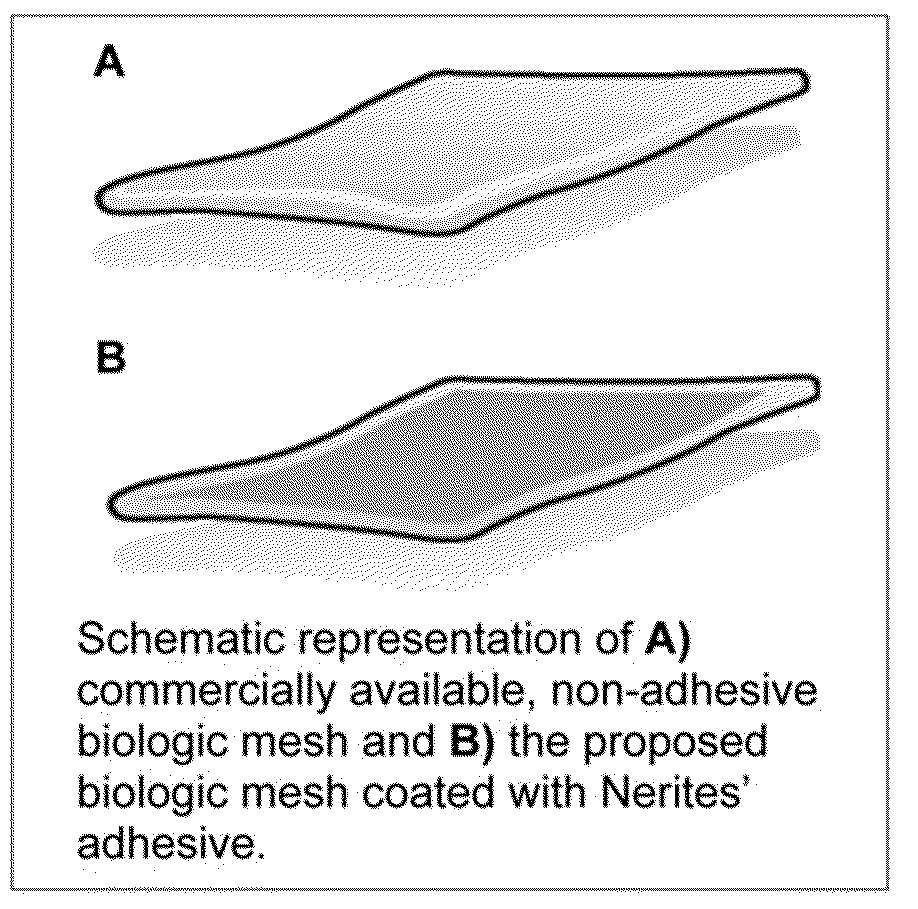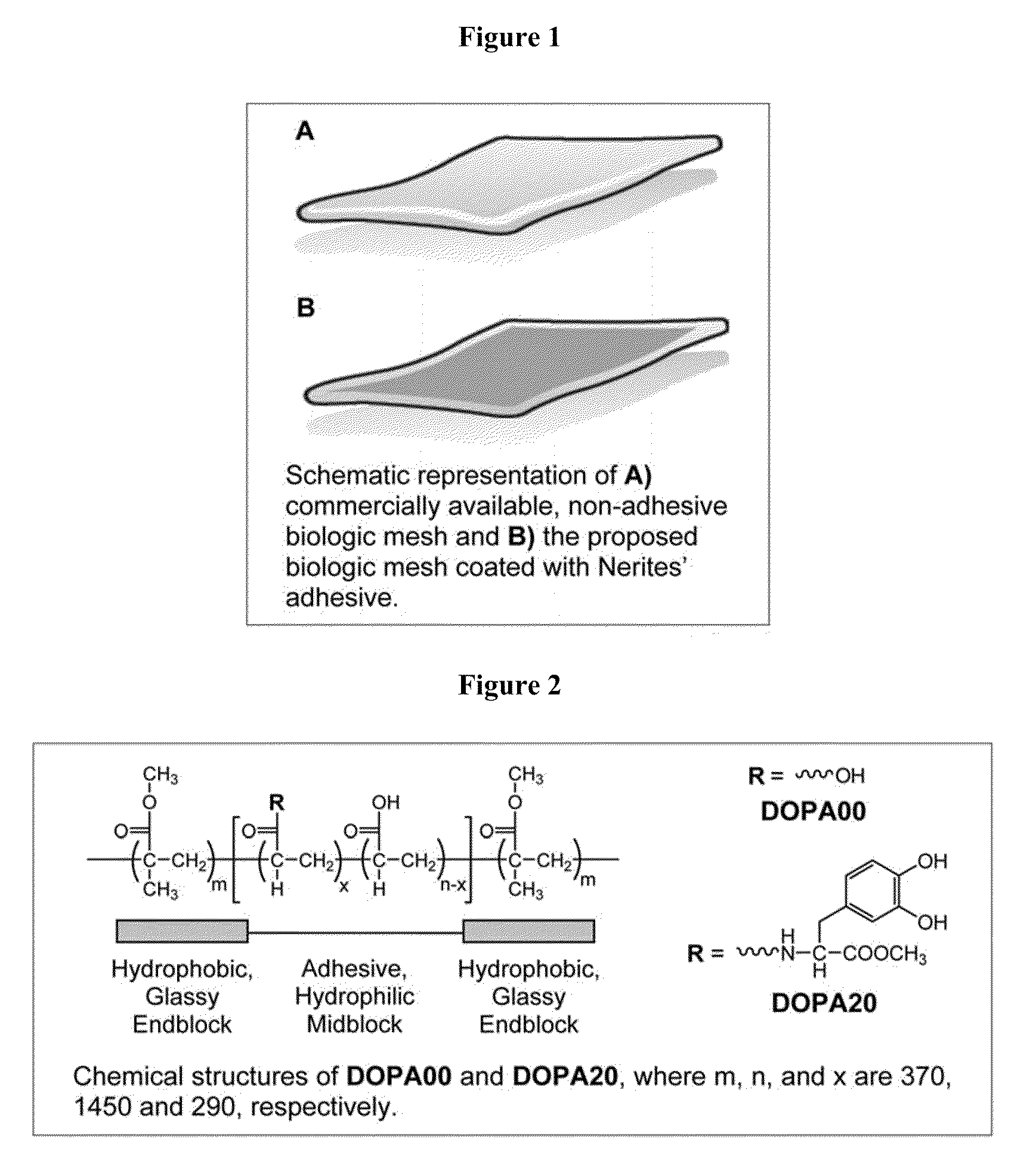Bioadhesive constructs
a technology of bioadhesive and constructs, applied in the field of bioadhesive constructs and substrates, can solve the problems of prosthetic mesh textile properties, increased risk of infection, and inability to meet the needs of patients, so as to prevent tissue and nerve damage, prevent potential long-term infection and chronic patient discomfort, and eliminate or reduce the need
- Summary
- Abstract
- Description
- Claims
- Application Information
AI Technical Summary
Benefits of technology
Problems solved by technology
Method used
Image
Examples
experiment 1
Synthesize New Polymers with Improved Adhesive and Mechanical Properties
[0083]New dopamine-modified adhesive polymers similar to those shown in FIG. 6 will be synthesized. These new polymers will vary in their dopamine content, hydrophilicity or hydrophobicity, and branching, all of which strongly influence both the interfacial adhesive and bulk mechanical properties of the polymer film. For example, although the presence of catechol is important for water-resistant adhesive properties, polymeric films having a catechol content of 33 wt % have exhibited poor adhesion underwater. This is likely due to the hydrophobic nature of the dihydroxyphenyl ring, which becomes inaccessible when the hydrophobic polymeric film collapses in the presence of water. Therefore, the dopamine content of the new polymers will be kept between 10 and 20 wt %. Additionally, lysine residues with free —NH2 groups will be incorporated adjacent to dopamine (similar to Medhesive-027, FIG. 6), which may render th...
experiment 2
Characterization of Polymeric Adhesive Film
[0258]Rationale
[0259]In this experiment, the adhesive films will be characterized by determining the extent to which they swell in an aqueous buffer, their in vitro rate of degradation, and their hydrophilicity through contact angle measurements. All three properties are interrelated and will affect the overall performance of the adhesive film. For example, the more hydrophilic the film is, the more water it can take up, causing it to swell more. This in turn increases the rate of degradation through hydrolysis. Large amounts of swelling are less desirable if the goal is to make a more cohesive film. However, the surface of the adhesive film needs to maintain a certain degree of hydrophilicity for the formation of good interfacial binding with wetted tissue surface. In addition to controlling the hydrophilicity of the film, chemical cross-links will be introduced through addition of an oxidizing reagent, which will be applied before each te...
experiment 3
Adhesion Test of the Bioadhesive Collagen Tape
[0266]Rationale
[0267]As the tendon is pulled along its axis, the adhesive film will experience shear forces. Therefore, the lap shear adhesion test will be peformed to determine the adhesive properties of the collagen membrane coated with adhesives. A second sheet of collagen membrane will be used as the substrate to simulate attachment to a tendon or ligament, since collagen makes up as much as 70% dry weight of these connective tissues.[27] Bone will also be tested as a substrate as well because the tendon-bone joint is typically the weak link in rotator cuff surgery.[12, 13, 20] Before forming the adhesive joint, an oxidizing reagent will be applied to the film. Oxidized catechol can form irreversible covalent bonds with various functional groups such as —NH2 (lysine) and SH (cysteine) likely to be present on biological substrates. [92] The effectiveness of forming these interfacial chemical bonds will likely affect the adhesive prope...
PUM
| Property | Measurement | Unit |
|---|---|---|
| Percent by mass | aaaaa | aaaaa |
| Percent by mass | aaaaa | aaaaa |
| Percent by mass | aaaaa | aaaaa |
Abstract
Description
Claims
Application Information
 Login to View More
Login to View More - R&D
- Intellectual Property
- Life Sciences
- Materials
- Tech Scout
- Unparalleled Data Quality
- Higher Quality Content
- 60% Fewer Hallucinations
Browse by: Latest US Patents, China's latest patents, Technical Efficacy Thesaurus, Application Domain, Technology Topic, Popular Technical Reports.
© 2025 PatSnap. All rights reserved.Legal|Privacy policy|Modern Slavery Act Transparency Statement|Sitemap|About US| Contact US: help@patsnap.com



